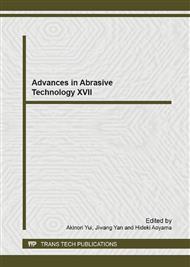p.129
p.135
p.141
p.147
p.154
p.160
p.166
p.175
p.181
Material Properties of a New PCD Made of Boron Doped Diamond Particles
Abstract:
In order to cope with various problems associated with machining of PCD, development of a new PCD possessing excellent tool properties and good machinability at the same time has been demanded. From this point of view, the authors have developed a new PCD, “EC-PCD (Electrically Conductive PCD)”, composed of boron doped diamond particles in place of the standard non-conductive diamond. In this research, investigation into material properties of the newly developed EC-PCD is made. Through the tests, it was found that the boron doped diamond particles (the source material of the new PCD) had an electrical resistivity of 1.6×10-4Ω·m and the thermal conductivity after sintering was lower than that of the standard PCD. In addition, it was confirmed that the electrical conductivity of the source diamond particles of the EC-PCD had not been lost even under the condition of high temperature and high pressure during the manufacture. As a result of the heat test, EC-PCD’s high resistance to oxidation at high temperatures was confirmed showing no changes in the surface condition even at 675oC while the surface of the S-PCD was largely changed at the same temperature. One of the reasons for this is guessed to be that EC-PCD is hard to react with the cobalt contained as a catalyst metal. Further, it was found in the friction tests using a steel ball that the friction coefficient of the EC-PCD was 50% higher than that of S-PCD at the room temperature though it dropped by 10-30% at the temperature of 80oC.
Info:
Periodical:
Pages:
154-159
Citation:
Online since:
September 2014
Authors:
Price:
Сopyright:
© 2014 Trans Tech Publications Ltd. All Rights Reserved
Share:
Citation:


